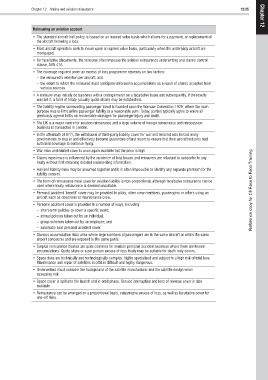Page 355 - M97TB9_2018-19_[low-res]_F2F_Neat2
P. 355
Chapter 12 Marine and aviation reinsurance 12/25 Chapter
Reinsuring an aviation account 12
• The standard aircraft hull policy is issued on an insured value basis which allows for a payment, or replacement of
the aircraft following a loss.
• Most aircraft operators seek to insure upon an agreed value basis, particularly when the underlying aircraft are
mortgaged.
• For facultative placements, the reinsurer often imposes the aviation reinsurance underwriting and claims control
clause, AVN 41A.
• The coverage required under an excess of loss programme depends on two factors:
– the reinsured’s retention per aircraft; and
– the extent to which the reinsured must anticipate unforeseen accumulations as a result of shares accepted from
various sources.
• A reinsurer may initially do business with a ceding insurer on a facultative basis and subsequently, if the results
warrant it, a form of treaty (usually quota share) may be established.
• The liability regime surrounding passenger travel is founded upon the Warsaw Convention 1929, where the main
purpose was to limit airline passenger liability to a reasonable sum. Today, parties typically agree to waive all
previously agreed limits on recoverable damages for passenger injury and death.
• The UK is a major centre for aviation reinsurance and a large volume of foreign reinsurance and retrocession
business is transacted in London.
• In the aftermath of 9/11, the withdrawal of third-party liability cover for war and terrorist acts forced many
governments to step in and effectively become guarantors of last resort to ensure that their aircraft industry had
sufficient coverage to continue flying.
• War risks and related cover is once again available but the price is high.
• Claims experience is influenced by the incidence of total losses and reinsurers are reluctant to subscribe to any
treaty without first obtaining detailed underwriting information.
• Hull and liability risks may be assumed together and it is often impossible to identify any separate premium for the
liability content.
• The form of reinsurance most used for aviation liability is non-proportional, although facultative reinsurance can be
used where treaty reinsurance is deemed unsuitable.
• Personal accident ‘benefit’ cover may be provided to pilots, other crew members, passengers or others using an Reference copy for CII Face to Face Training
aircraft such as observers or maintenance crew.
• Personal accident cover is provided in a number of ways, including:
– short-term policies to cover a specific event;
– annual policies taken out by an individual;
– group schemes taken out by an employer; and
– automatic seat personal accident cover.
• Obvious accumulation risks arise where large numbers of passengers are in the same aircraft or within the same
airport concourse and are exposed to the same perils.
• Surplus reinsurance treaties are quite common for aviation personal accident business where there are known
accumulations. Quota share or a per person excess of loss treaty may be suitable for death only covers.
• Space risks are technically and technologically complex, highly specialised and subject to a high risk of total loss.
Maintenance and repair of satellites in orbit is difficult and highly dangerous.
• Underwriters must consider the background of the satellite manufacturer and the satellite design when
assessing risk.
• Space cover is split into the launch and in-orbit phase. Service interruption and loss of revenue cover is also
available.
• Reinsurance can be arranged on a proportional basis, catastrophe excess of loss, as well as facultative cover for
one-off risks.

